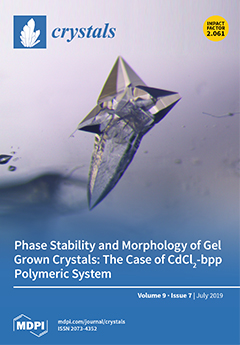The synthesis, crystal structures, and magnetic properties of a new two-dimensional (2D) Hofmann-like series, Fe
II(L)
2[Ag
I(CN)
2]
2 (L = 3-cyano-4-methylpyridine (
1), allyl isonicotinate (
2), phenyl-isonicotinate (
3), and benzyl nicotinate (
[...] Read more.
The synthesis, crystal structures, and magnetic properties of a new two-dimensional (2D) Hofmann-like series, Fe
II(L)
2[Ag
I(CN)
2]
2 (L = 3-cyano-4-methylpyridine (
1), allyl isonicotinate (
2), phenyl-isonicotinate (
3), and benzyl nicotinate (
4)) were studied. These compounds have a 2D sheet structure because of their strongly determinate self-assembly process. An octahedral Fe
II ion is coordinated with the nitrogen atoms of[Ag
I(CN)
2 linear units at equatorial positions and monodentate pyridine derivatives at the axial position. The layers construct a parallel stacking array. Compounds
1–
3 show pairs of layers constructed by intermetallic Ag···Ag interactions. Compound
4 shows a mono-layer structure. The substituent bulk of the ligands affects the interlayer space. Compounds
1–
4 undergo a 100% spin transition. However, compound
1, incorporating a smaller group, has a relatively lower critical temperature (
Tc = 182 K (
1),
Tc = 221 K (
2),
Tc = 227 (
3) and
Tc1 = 236 K,
Tc2 = 215 K (
4)). We investigated the correlations between our systematic crystal design, substituent size, and the spin crossover profiles.
Full article





